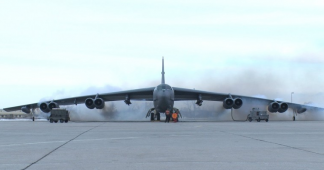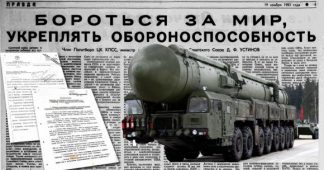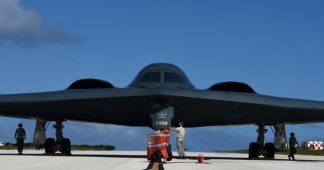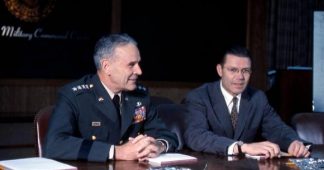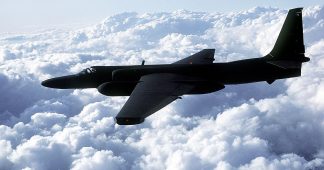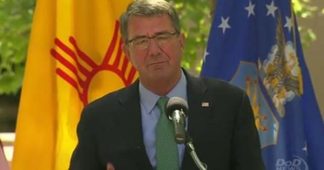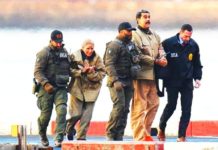Published: Feb 25, 2019
Declassification of Red Dot “Emergency War Orders” from 1964 Opens Window into Strategic Operations
SAC’s Role in DEFCON System Detailed
Wasington D.C., February 25, 2019 – A recently declassified Strategic Air Command (SAC) checklist sheds brand new light on the procedures that SAC would have followed in the mid-1960s if U.S. nuclear forces had gone to war. The National Security Archive at The George Washington University is today posting this intriguing document for the first time.
The checklist provides the first fully declassified details of SAC procedures under Defense Readiness Conditions (DEFCON), from 1 to 5, along with the Emergency War Order red dot messages that would have directed SAC bombers and missiles to launch nuclear strikes against the Soviet Union and other targeted adversaries.
Independent scholar Robert S. Hopkins III obtained the new material through research in recently declassified U.S. Air Force records. He kindly provided the documentation, introduction, and document descriptions for this posting.
* * * * *
How the Strategic Air Command Would Go to Nuclear War
by Robert S. Hopkins, III
During the Cold War the Strategic Air Command (SAC) kept its bomber and missile forces at high alert, with strategic bombers adjacent to runways slated for rapid launch. In event of a crisis or a sudden outbreak of general war or even a decision for a preemptive attack, SAC’s bomber, tanker, and missile forces could respond with varying degrees of preparedness. SAC’s readiness for war was defined by the Defense Readiness Condition (DEFCONs) and the Emergency War Order (EWO) directed by the National Command Authority (NCA), the president and the secretary of defense. Yet tight secrecy controls shrouded the mechanics of these processes while the cryptological nature of the actual launch and execution messages made them inaccessible.[1] A recently declassified SAC combat wing checklist from 1964 published today by the National Security Archive for the first time discloses specific SAC actions at each DEFCON level as well as the Emergency War Orders used to direct the launch and execution process of SAC’s highly orchestrated alert force.
The checklist was used in September 1964 by the 55th Strategic Reconnaissance Wing (SRW) at Forbes AFB, KS. The 55th SRW controlled two squadrons of Boeing RB-47 electronic intelligence (ELINT) aircraft and one squadron of Convair SM-65E Atlas intercontinental ballistic missiles (ICBM).[2] The RB-47s were used for one of the wing’s primary missions: aerial reconnaissance.[3] As part of its EWO commitments, the 55th SRW distributed a secret checklist “so individuals directly associated with EWO launch of aircraft and missiles will readily understand their tasks.” The checklist included, inter alia, an EWO synopsis, EWO messages, DEFCON summaries, and Command Post functions, as well as aircraft and crew disposition and EWO mission assignments. These were specified by the Single Integrated Operations Plan (SIOP), the Joint Chiefs of Staff plan for nuclear war, in this instance SIOP-64 Revision 2.
EWO checklists such as the one used by the 55th SRW facilitated the timely management of SAC’s ongoing ground and airborne alert programs that improved its war readiness. SAC began evaluating quick-response ground alert in October 1955, but the Joint Chiefs of Staff (JCS) deferred any action until July 1957 with the establishment of ground alert for B-47s at bases in the United Kingdom. This expanded to include ground alert in the U.S. of both bombers and tankers by 1960, with the goal of having 30 percent (later 50 percent) of its aircraft able to launch within 30 minutes of notification, which dropped to 15 minutes with the introduction of Soviet ballistic missiles. Airborne alert tests began in January 1958 using B-36s, and by 1959 included B-52s. The Chrome Dome airborne alert program was approved on 6 November 1961 and ended after the crash of a nuclear-bomb-laden B-52 near Thule, Greenland, in January 1968.[4] In either case, bombers were launched under “positive control”, which meant they were authorized only to take off and fly to their positive control checkpoint (their “failsafe” point) where they would orbit until they received an execution message issued by the JCS.
Emergency War Order Synopsis
To ensure that all US forces operated on a common timetable, the JCS established several key “hours” associated with the EWO and SIOP. H-hour served as the absolute start time for all operations. Designated by the JCS or by SAC’s Commander-in-Chief (CINCSAC), depending on the circumstances, “A” hour referred to the beginning of the generation of forces to raise their alert level. The Joint Chiefs could also designate an “E” hour (later Execution Reference Time—ERT) indicating the execution time of the SIOP strike force. “L” hour, not mentioned in the checklist, was the reference time used for the Positive Control Launch of any components of the SAC aircraft alert force; it also established DEFCON 1 and the “A” hour for SAC.
In the event an “A” hour was declared, the 55th SRW would deploy 11 RB-47Hs to Whiteman AFB, MO, in preparation for their EWO mission. As the RB-47s were configured primarily for ELINT collection their chief mission would be to detect the operational electronic signatures of hostile forces. With the declaration of an “E” hour, dispersal would halt and the RB-47s would launch from Forbes or their dispersal base at Whiteman. Once executed and launched, three of these would “reconnoiter the Far East and Post-Strike in Japan” while the remaining eight airplanes would “reconnoiter the European Area and Post-Strike in Europe and the United Kingdom.” Their immediate goal was to meet their Air Refueling Control Time (ARCT) when an air tanker would be at hand to refuel the RB-47s en route to their EWO deployment areas in Europe and Japan. Meanwhile, the 548th Strategic Missile Squadron (SMS) would launch nine Atlas Es to their targets. By early 1965 the Atlases would be retired, rendered obsolete by the quick-launch Minutemen.
Emergency War Order Messages
Perhaps the most significant part of the checklist is the recap of EWO messages. There are two categories: EWO Index and EWO Preparation Index. The former, known as Red Dot messages, were for use when war was imminent or underway. They authorized the launch and execution of SAC forces on their EWO routes, where, depending on instructions provided by Emergency Action Messages from the NCA, they would implement one of the options provided by the SIOP. The latter, the Blue Dot messages, covered arrangements that preceded the execution of EWOs, such as DEFCON levels, reaction postures, and command arrangements.
No doubt their specific applications evolved over time, but the implementation of these messages was quite straightforward and applied to all SAC forces, including B-47, B-52, and B-58 bombers, KC-97 and KC-135 tankers, EB-47L and KC-135A/B airborne command posts, and Atlas, Titan, and Minuteman ICBMs. For example, a B-52 crew responding to an alert klaxon would decode the message broadcast over the base’s command post radio frequency while starting the aircraft’s engines. The decoded message might be a preparatory alert notification Blue Dot AA7 “Minimum Reaction Posture, Aircraft”. The bomber’s engines would be shut down and the crew remained in the aircraft ready to launch with minimal delay. Other Blue Dot messages notified crews of a change in the DEFCON, the dispersal and recovery of the B-47 alert force, or a change involving the CINCSAC provided for by pre-delegation arrangements.[5]
A Red Dot 1 message directed the positive control (PC) launch of all Alfa Force airplanes on daily alert. This directed the bombers to their positive control point. Assuming that the Alfa Force had already launched, a Red Dot 2 message launched the recently generated Charlie Force. In the event of a mass simultaneous launch of all SAC bombers and tankers (Herman Kahn’s “wargasm”), the Red Dot 3 message launched the Alfa alert bombers, the Charlie generated airplanes, and the “Foxtrot force,” the last group of bombers and tankers to go on alert. In SAC planning, the “Foxtrot force” had the function of a reserve force that could be used in retaliatory missions.[6]
In all cases the Red Dot positive control messages restricted the bombers to proceed only to their positive control point, Once the NCA decided to proceed with nuclear attacks on targets specified in each bombers’ combat mission folder (CMF), SAC would broadcast a Red Dot 4 message to execute their mission, and the bombers would then continue to their targets.
In the event of gradual escalation, bombers reached and orbited at their PC points in the expectation that their highly visible presence would convince the Soviet leadership of U.S. resolve, ending the crisis. Should this fail, a Red Dot 4 “execution order” would then be transmitted to launch SAC’s ICBMs and release the bombers from their PC points to their targets. Presumably the Red Dot 4 message could be used in the event of a “bolt from the blue” scenario, ordering the immediate launch of ICBMs and all alert and non-alert forces that were available for launching. In this event the bombers proceeded directly to their targets without pausing at their PC point or requiring an additional execution message. Red Dot 6 may have been a placeholder reserved for an unspecified contingency plan. Red Dot 7, “Strike Execution Big Jump,” may have been a terminate order.
DEFCON
The Checklist provides the first full declassification of SAC operations at various DEFCON levels. The airborne and ground alert operations discussed earlier were keyed into the DEFCONS, which corresponded to different levels of international tension. The lowest is DEFCON 5, which reflects “normal peacetime conditions.” For many years SAC maintained its forces at DEFCON 4, which included enhanced intelligence activities, security alertness, and a greater degree of preparedness in the event the DEFCON increased. At DEFCON 3 (seen during the 1973 Arab-Israeli War in response to potential Soviet intervention) the battle staff at each SAC base would assemble and prepare dispersal plans for implementation. Base security was heightened and flying operations were restricted to a four-hour radius from the base. ICBMs not on alert or undergoing maintenance would be generated and placed on alert using a 24-hour work schedule. The airborne component of the Post Attack Command and Control System (PACCS), including the Looking Glass airborne command post and radio relay aircraft, would be launched.[7]
DEFCON 2 required the “immediate generation of the SAC force,” putting all forces, bombers, and ICBMs on high alert. All personnel would return from leave and all crews for “first cycle aircraft”—those launched in the first wave of an attack—were restricted to base. Except for airborne alert missions underway, airborne command post operations, and test aircraft, all flying would stop so that the bomber force could be readied for use. Moreover, officers would distribute Combat Mission Folders (stipulating routes and targets) to crews to permit briefings and folder review.
The DEFCON 2 status of ICBMs was also complex. The ICBM force of Atlas and Minuteman missiles was undergoing development, with some missiles under the control of the Air Force Systems Command (AFSC), which was responsible for testing and deployment of Air Force weapons. Under an AFSC-SAC Emergency Combat Capability (ECC) agreement, AFSC gave SAC temporary operational control of all AFSC missiles at Vandenberg AFB, CA, and Cape Canaveral AFS, FL, that could be configured with nuclear warheads and launched.[8] Under DEFCON 2, missile launch crews would go in the “MINIMIZE” posture eliminating all non-essential communications and restricting missile control sites to crews only. Moreover, launch crews prepared themselves to go to the next level of readiness.
During the 1962 Cuban Missile Crisis, SAC was at DEFCON 2. All non-critical flying ceased and aircraft undergoing maintenance were made sufficiently flyable to carry out an EWO strike. SAC readied for launch 1,436 bombers and 145 missiles and maintained a “continuous stream” of B-52 bombers on airborne alert, 65 in the air at any given time, ready to fly to their targets.[9]
Should U.S. forces move to DEFCON 1, SAC would take steps preparing for the NCA’s execution order. Bomber and tanker crews would report to their aircraft, start engines, and receive a Blue Dot AA6 message indicating the change in DEFCON. Crews would then shut down the engines and remain in their airplanes. As the EWO checklist noted, “Each SAC Commander must prepare his aircraft and crews for launch as rapidly as possible and must be prepared to maintain them in ‘cocked’ configuration within the limitations imposed by the readiness condition order for an indefinite period of time.” ICBM crews would take their assigned positions at launch control center consoles and personnel would stay in the centers as long as missiles were in “alert configurations.” Power generators used for launching missiles would go on-line. SAC also had a DEFCON 1M level which stipulated that “ICBMs will be counted down to point of minimum hold,” meaning that they were ready for instant launch.
As the SIOP and the related EWOs evolved in complexity during the 1970s and 1980s, EAMs struggled to remain simple enough to avoid ambiguity and the risk of misapplication by crews. Specific JCS messages tied to specific Major Attack Options (MAO) and Selected Attack Options (SAO) replaced the Red Dot messages. SAC messages replaced the Blue Dot messages, with specific SAC actions for each message built into bomber/tanker CMFs. Missiles were a separate case.
Note: The author wishes to acknowledge the efforts of George Cully in acquiring this document, and comments by William Burr and David Rosenberg.
The documents
Source: Freedom of Information request by Robert S. Hopkins
Notes
[1] See, for example, Paul Bracken, The Command and Control of Nuclear Forces (New Haven, CT: Yale University Press, 1983), at 22: “…the exact details of how America’s nuclear forces would go to war are justifiably classified…” Since Bracken wrote, much information about the SIOP and nuclear war planning has been declassified, including some details about the early “Football,” but procedural information has remained classified.
[2] The unusual assignment of an ICBM squadron to a reconnaissance wing was purely a temporary administrative matter. As the senior SAC organization at Forbes AFB, the 55th SRW acquired the 548th Strategic Missile Squadron (SMS) on 1 August 1964 when its parent SAC 40th Strategic Aerospace Wing and 21st Strategic Air Division inactivated. The 548th SMS was itself inactivated on 25th March 1965 after its last missile was removed on 8 February.
[3] The 55th SRW was SAC’s premier peripheral reconnaissance unit. On 1 July 1960, two months after the loss of a Central Intelligence Agency (CIA) U-2 over the USSR, a Soviet MiG-19 Farmer attacked and shot down a 55th SRW RB-47H operating from RAF Brize Norton in England. During 1966 the wing relocated to Offutt AFB, NE, where it remains operational. C. Mike Habermehl and Robert S. Hopkins, III, Boeing B-47 Stratojet: Strategic Air Command’s Transitional Bomber (Manchester, England: Crécy Publishing, Ltd., 2018), 127-31, 153-67; and Robert S. Hopkins, III, Spyflights and Overflights: U.S. Strategic Aerial Reconnaissance, vol. 1, 1946-1960 (Manchester, England: Crécy Publishing, Ltd., 2016), 38-59.
[4]. Robert S. Hopkins, III, Boeing KC-135 Stratotanker: More Than a Tanker (Manchester, England: Crécy Publishing, Ltd., 2017), 72-77. For the Thule accident, see “Newly Released Sandia Labs Film Presents Story of U.S. Nuclear Weapons Safety Effort,” National Security Archive Electronic Briefing Book 498, December 23, 2014.
[5]. This was a pre-delegated chain of command beginning with the Vice CINCSAC followed by SAC’s Numbered Air Force (NAF) commanders based on date of rank, with the Airborne Emergency Action Officer—AEAO—on a SAC airborne command post serving as interim commander until the successor was in place. The AEAO was designated as the final commander should the others be inaccessible. History of Strategic Air Command, July-December 1966, 7-11.
[6] Alert categories such as Alfa and Charlie should not be confused with mission tasking as defined by National Strategic Targeting and Attack Policy (NSTAP). For example, under SIOP-4, the NSTAP stipulated three major “tasks” which could be executed in any of five primary attack options. Alpha and Bravo were strictly counterforce missions aimed at time-urgent nuclear threat targets and non-nuclear military forces respectively, while the Charlie task targeted war-supporting urban-industrial targets. See General Maxwell Taylor to General LeMay et al., “Review of the SIOP Guidance,” 5 June 1964, 10-13.
[7]. On the operational history of PACCS, see Hopkins, Boeing KC-135 Stratotanker, Chapter 9, “Managing Nuclear War”; and Habermehl and Hopkins, B-47 Stratojet, 70-72.
[8].Scott Sagan, The Limits of Safety: Organizations, Accidents, and Nuclear Weapons (Princeton: Princeton University Press, 1993). 78.
[9]. L. Wainstein et al;, The Evolution of U.S. Strategic Command and Control and Warning, 1945-1972 (Arlington, VA: Institute for Defense Analyses, 1975), 329, National Security Archive Electronic Briefing Book 403, Document 2, November 19, 2012
Published at https://nsarchive.gwu.edu/briefing-book/nuclear-vault/2019-02-25/how-strategic-air-command-would-go-nuclear-war
